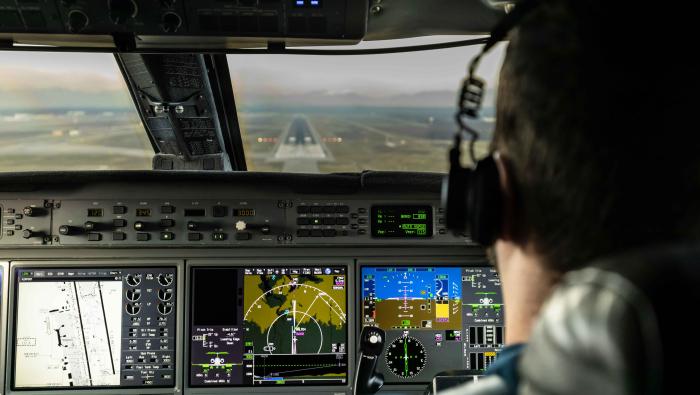At the Air Charter Safety Foundation (ACSF) Safety Symposium held in early April, speakers and participants shared important safety information, lessons learned, and opportunities for improvement. The symposium began with an acknowledgment that the business aviation industry hasn’t gotten off to a good start in the first quarter, with three fatal business jet accidents and nine fatalities occurring in the U.S., up from two accidents and two fatalities during the same period last year.
Held at Embry-Riddle Aeronautical University, not only was the ACSF Symposium an opportunity for business aviation operators to share safety ideas, but the organization also welcomed Embry-Riddle students to participate and learn more about business aviation safety. The event began on April 1 with a panel of industry experts sharing their career experiences, and this was well-attended by Embry-Riddle students who are interested in business aviation opportunities.
|
You don’t see air traffic controllers when you travel, but if your trips are trouble-free, they deserve considerable credit. At least a dozen of them track the progress of every flight you take.
Their work starts even before you take off. First, your pilots contact ATIS, a continuously updated recording that reports the active runway number, weather conditions, and other data. Then they call clearance delivery to obtain the route that they must follow from the departure airport to their destination. Next they contact ground control and advise it that they have the ATIS information and a clearance and are ready for taxi instructions. Only after the crew acknowledges those instructions is the aircraft ready to taxi from the parking ramp to the runway.
|
The U.S government’s Internal Revenue Service (IRS) audited aircraft management firms and tried to impose the federal excise tax (FET) on fees charged by the firms to aircraft owners. According to industry sources, IRS agents targeted major charter/management firms, although the firms allegedly being audited didn’t wish to speak to AIN about their experience with the IRS.
The FET, also known as the ticket tax, was designed by legislators to provide a taxing mechanism for people flying commercially on airline and charter aircraft. The tax is applied as a segment fee, usually 7.5 percent of the amount charged to the passenger for a flight. Perhaps because airlines unbundled their services and now charge separately for the flight and untaxable baggage, meals, and other services such as a few more inches of legroom, FET collections from airlines may have dropped. Couple that with the government’s ongoing budget shortfalls and it appeared that IRS auditors were on the lookout for more ways to extract money from business jet operators.
|
For its entire history of more than eight decades, Hampton Roads Executive Airport (KPVG) has been privately owned and has endured bankruptcy twice. That trend was reversed in 2000 when the original principals of Virginia Aviation Associates purchased its 230 acres and then the following year acquired an additional 400 acres, paving the way for expansion. “Being a privately-owned airport, we own everything vertically, so to speak,” explained majority owner Steve Fox, adding that KPVG is a public-use reliever airport for nearby Norfolk International. “We own all the land, all the buildings, and the FBO.”
As a family business, the ownership embarked on an aggressive development program, with Phase 1 consisting of many improvements to the airport, including the construction of a new 5,350-foot-long, 100-foot-wide runway, which can handle aircraft up to Boeing Business Jets.
|
Get a front row seat to see, feel, and hear a rocket launch. It's definitely an experience unlike any other and is one of the recurring things to do on many people's bucket list.
So Business Jet Traveler contributor Kimberly Button has got your back, highlighting four places where one can view a rocket launch. While Kennedy Space Center in Central Florida is an obvious choice to experience one, a location in Kazakhstan isn't nearly as well known.
|
Joby Aviation is taking the wraps off the software system it has developed to support on-demand commercial air taxi services with its four-passenger eVTOL aircraft, which could enter service in 2025. Called “ElevateOS,” the suite of software tools includes a flight-booking mobile app for customers, a planning tool for pilots, and an intelligent matching engine that connects available pilots, aircraft, and ground infrastructure resources for each journey.
“This is laying the foundation for what really is required to have an effective commercial service,” Bonny Simi, Joby’s president of operations, told AIN.
|
Several studies have identified the use of erroneous takeoff parameters as a safety issue. All pilots are vulnerable since the problem is not specific to any one aircraft type, region, or operator. Using erroneous takeoff parameters can result in early rotation causing a tail strike, collision with obstacles in the departure path, loss of control after takeoff, or a runway overrun.
Several recent incidents and accidents have involved intersection takeoffs, where pilots either take off from the wrong intersection or make errors while calculating takeoff performance parameters.
|
Top Stories This Week on AINonline
|
AINalerts News Tips/Feedback:
News tips may be sent anonymously, but feedback must
include name and contact info (we will withhold name on request). We reserve the
right to edit correspondence for length, clarity, and grammar. Send feedback or
news tips to AINalerts editor Chad Trautvetter.
|
AINalerts is a publication of AIN Media Group, 214 Franklin Avenue, Midland Park, New Jersey. Copyright 2023. All rights reserved.
Reproduction in whole or in part without permission is strictly prohibited.
|
|












